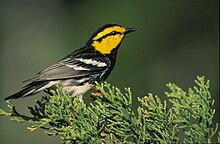
The Edwards Plateau is a geographic region forming the crossroads of Central, South and West Texas, United States. It is named in honor of Haden Edwards. It is bounded by the Balcones Fault to the south and east; the Llano Uplift and the Llano Estacado to the north; and the Pecos River and Chihuahuan Desert to the west. San Angelo, Austin, San Antonio and Del Rio roughly outline the area. The plateau, especially its southeast portion, is also known as the Texas Hill Country.

The lark sparrow is a fairly large New World sparrow. It is the only member of the genus Chondestes.

The myrtle warbler is a small New World warbler. It is considered a subspecies of the yellow-rumped warbler and its own species by different classification societies. The myrtle warbler has a northerly and easterly distribution, with the Audubon's warbler further west. It breeds in much of Canada and the northeastern United States. It is migratory, wintering in the southeastern United States, eastern Central America, and the Caribbean. It is a rare vagrant to western Europe, and has wintered in Great Britain.

The yellow-rumped warbler is a regular North American bird species that can be commonly observed all across the continent. Its extensive distribution range connects both the Pacific and Atlantic coasts of the U.S. as well as Canada and Central America, with the population concentrating in the continent's northern parts during the breeding season and migrating southwards to southern North and Central America in Winter. The species generally prefers coniferous forests or mixed coniferous-deciduous forests as its breeding habitat, while during the winter it can be found inhabiting more open areas such as shrublands that offer food resources. The diet of the yellow-rumped warbler is based primarily on insects, though the species does eat fruits such as juniper berries as well, especially in winter.

The Blackburnian warbler is a small New World warbler. They breed in eastern North America, from southern Canada, westwards to the southern Canadian Prairies, the Great Lakes region and New England, to North Carolina.
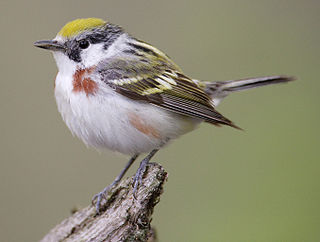
The chestnut-sided warbler is a New World warbler. They breed in eastern North America and in southern Canada westwards to the Canadian Prairies. They also breed in the Great Lakes region and in the eastern United States.

The magnolia warbler is a member of the wood warbler family Parulidae.

The yellow warbler is a New World warbler species. Yellow warblers are the most widespread species in the diverse genus Setophaga, breeding in almost the whole of North America, the Caribbean, and down to northern South America.

The bay-breasted warbler is a small species of songbird in the New World warbler family, Parulidae. It is one of thirty-four species in the diverse genus Setophaga. Like all songbirds, or passerines, the species is classified in the order Passeriformes.

The black-and-white warbler is a species of New World warbler, and the only member of its genus, Mniotilta. It breeds in northern and eastern North America and winters in Florida, Central America, and the West Indies down to Peru. This species is a very rare vagrant to western Europe.
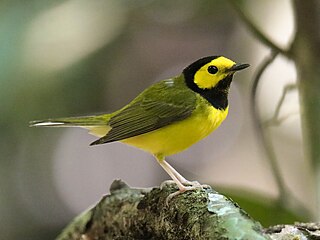
The hooded warbler is a New World warbler. It breeds in eastern North America across the eastern United States and into southernmost Canada (Ontario). It is migratory, wintering in Central America and the West Indies. Hooded warblers are very rare vagrants to western Europe.
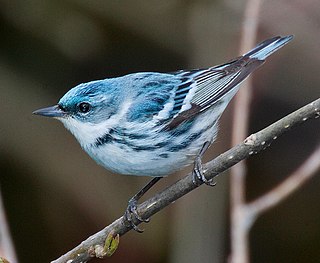
The cerulean warbler is a small songbird in the family Parulidae. It is a long-distance migrant, breeding in eastern North American hardwood forests. In the non-breeding season, it winters on the eastern slope of the Andes in South America, preferring subtropical forests.

The pine warbler is a small songbird of the New World warbler family.

Kirtland's warbler, also known in Michigan by the common name jack pine bird, or the jack pine warbler, is a small songbird of the New World warbler family (Parulidae). Nearly extinct just 50 years ago, populations have recovered due to the conservation efforts of Phil Huber and the U.S. Forest Service. It requires large areas, greater than 160 acres, of dense young jack pine for its breeding habitat. This habitat was historically created by wildfire, but today is created through the harvest of mature jack pine, and planting of jack pine seedlings.
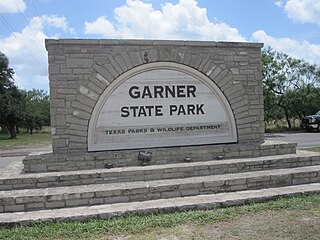
Garner State Park is a state park in the community of Concan, Texas located in Uvalde County, Texas in the United States. Garner State Park, in the Texas Hill Country, is the most popular state park in Texas for overnight camping. It often fills by noon in peak parts of the season. The park is popular with campers and local residents for its activities on the Frio River and the dances held nightly during the spring and summer.

The black-throated gray warbler or black-throated grey warbler is a passerine bird of the New World warbler family Parulidae. It is 13 cm (5.1 in) long and has gray and white plumage with black markings. The male has the bold black throat of its name, and black stripes on its head, as well as black streaks on its flanks; the female is a paler version of the male, with a white throat and less distinct black markings on the flanks and wings. It breeds in western North America from British Columbia to New Mexico, and winters in Mexico and the southwestern United States. The habitats it prefers are coniferous and mixed forests and scrubland, especially those with pinyon pines, junipers, sagebrush, and oaks. Its nest is an open cup of plant fibers lined with feathers, built a few metres from the ground in the branches of a tree or shrub. Three to five eggs are laid, and young are fed by both parents. Common in its breeding range, it does not seem to be seriously threatened by human activities, unlike many migratory warblers.

Townsend's warbler is a small songbird of the New World warbler family.

The black-capped vireo is a small bird native to the United States and Mexico. It was listed as an endangered species in the United States in 1987. It is the only Vireo that is sexually dichromatic. Recovery of the species' population contributed to its delisting in 2018. The IUCN lists the species as "near threatened."

The elfin woods warbler is a species of bird endemic to Puerto Rico, where it is local and uncommon. Discovered in 1968 and described in 1972, it is the most recently described New World warbler.

Balcones Canyonlands is a national wildlife refuge located in the Texas Hill Country to the northwest of Lago Vista, Texas. The refuge was formed in 1992 to conserve habitat for two endangered songbirds, the golden-cheeked warbler and the black-capped vireo, and to preserve Texas Hill Country habitat for numerous other wildlife species. The refuge augments a similarly named preserve in Austin called the Balcones Canyonlands Preserve.
Hutchinson, & Scalise, J. L. (2019). FIRST OBSERVATION OF BLUE JAY (CYANOCITTA CRISTATA) DEPREDATING A GOLDEN-CHEEKED WARBLER (SETOPHAGA CHRYSOPARIA) NEST. The Southwestern Naturalist, 64(1), 53–55. https://doi.org/10.1894/0038-4909-64-1-53
